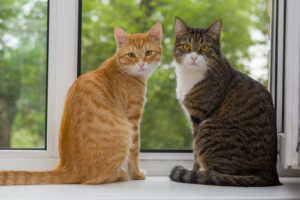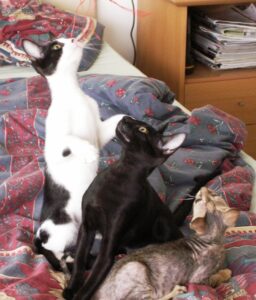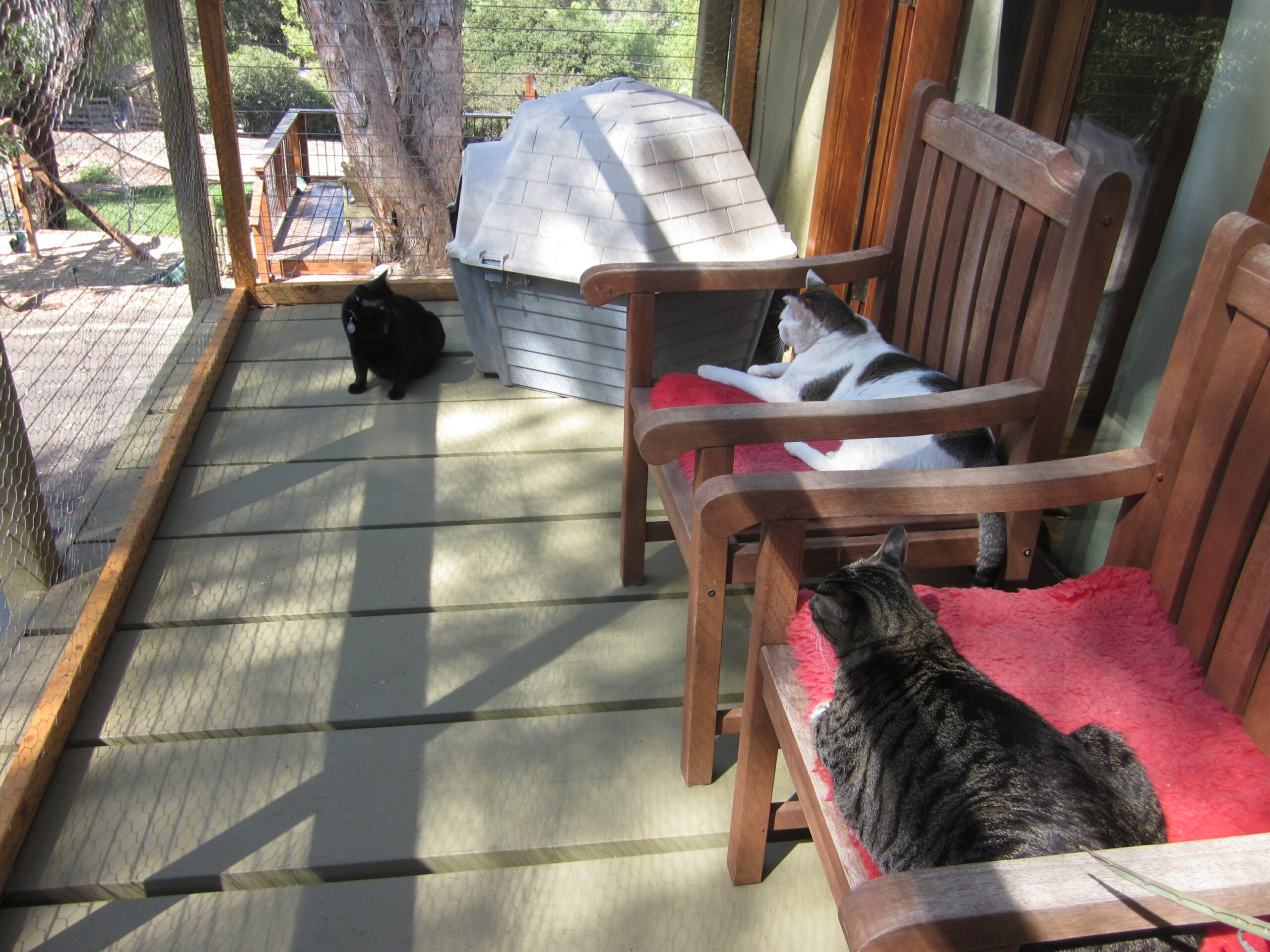Barks Blog
A Change of Lifestyle
By Marilyn Krieger

According to a study by the Humane Society of the United States, based on data collected from 600 veterinarians, two out of three veterinarians recommend keeping cats indoors, citing vehicles and transmittable diseases as the two greatest potential dangers (HSUS Veterinarian Study, June 2001).
Many cats enjoy napping in the yard or chasing insects. Many more are “street cats” who patrol the neighborhood, coming home only when it is time for dinner. Cats who are allowed to go outside face risks of being stolen, contracting parasites and diseases, engaging in fights with other animals and being poisoned. There are other hazards to add to this lengthy list. These include natural and man-made disasters such as earthquakes, hurricanes and fires. Additionally, the emergence of new diseases, such as bird flu and resistant forms of panleukopenia, are another threat to outdoor cats.
In my opinion it is time for a feline lifestyle change. For the sake of the cats, owners need to start bringing them indoors permanently where they can live longer, healthier lives.
Here is the dilemma: How does one convince the outdoor-loving cat that she should undergo a major lifestyle change and stay indoors where it is warm and safe? Every cat is unique with his or her own personality. Some cats welcome the opportunity to live permanently indoors. Others take a little more work and patience to transition them to indoor living.
The first step is spaying/neutering. This helps keep the cat population down and reduces the risks of diseases such as pyometra and testicular cancer. It also helps eliminate frustration, stress and typical behaviors such as spraying, howling and fighting.
The easiest time to transition an outdoor cat to the comforts of home is winter, when the weather is cold and miserable. Most cats will choose a warm spot on a couch over trying to keep dry under a bush. The transition will also go more smoothly by making the cat’s home more appealing.
Food as a Motivator
Owners making this transition should begin by feeding their cat exclusively indoors. She should not have access to food or treats outside—ever. The chosen location should be safe from other resident animals and children. The food should not be left lying around for her to munch on whenever she is hungry. Instead, kitty needs a consistent feeding schedule. She should be fed at the same time every day, two-three times a day. If the cat enjoys attention, owners should play with her and pet her before and after meals. In order to avoid the eat-and-run mentality, the time the cat stays inside after feasting can be extended gradually.
Owners can further coerce cats to come inside between meals by playing with them and providing deal-breaking treats—but only when the cat is indoors. They can also brush and cuddle their cat while she is indoors—if she enjoys that type of attention.
Activities
As part of the lifestyle change from street cat to house cat, owners have to convince their felines that relocating permanently inside is much more interesting and fun than outdoors. There is a plethora of fascinating activities for cats outside, including a diversity of objects to climb on, lots of space to explore, places to hide and critters to chase. Owners need to be creative and “bring the outdoors in.”
Many of these activities can be done inside the safety of the home. Playing with cats in a way that helps satisfy their hunting instincts is an excellent start. Owners can use a pole-type toy and pull it away from the cat to encourage her to chase it. Of course, she must be allowed to “catch” her prey sometimes to avoid the possibility of frustration. After the last catch, owners should immediately feed their cats. She will most likely eat, then groom and fall asleep. Other activities that will influence her to stay inside include treasure hunts and treat rolls. Hiding treats the cat adores in toys, on shelves or other areas will make the cat jump, climb and search for them. Treat rolls are fun too, i.e. rolling treats on the floor or down a flight of stairs for the cat to chase.
A Richer Environment

Enriching the environment with items that interest the cat will also help transition her into an indoor-loving cat. Cats need high places, such as cat trees, perches and shelves to jump on and climb up to. When buying or constructing vertical territory, owners should make sure the bases are sturdy so they do not topple over when things get a little energetic. Household furniture and architectural elements can also become part of the vertical territory solution. One can never have too much vertical territory.
Scratchers are important too. All cats need to scratch for a variety of reasons, including nail maintenance and marking territories. For more information on why cats scratch, see How Do I Get My Cat to Stop Scratching the Furniture? Cats will also scratch objects when they are stressed and feeling conflicted, when they are playing and after a nap. Place horizontal scratchers as well as scratching posts around your house in all of the areas your kitty hangs out in. Horizontal scratchers and vertical scratching posts should be placed around the house in all the areas the cat frequents.
Enticing toys will also keep cats busy and focused on indoor activities. Cats should be given a variety of toys, including ball and pull toys, soft toys to chase and interactive toys. Some cats enjoy chasing ping-pong balls, especially after they are rubbed with catnip. Owners can rotate toys so the cat does not become bored.
If the cat has never used a cat box or has gotten into the habit of using the great outdoors, owners will need to teach her proper litter-box etiquette. This entails starting with three-four large, uncovered litter boxes in different locations. Owners should encourage the cat to use the boxes by filling them with 2-3 inches of unscented clay litter combined with garden soil. After she uses the boxes, they can slowly increase the amount of litter and decrease the garden soil.
Keeping cats inside can reduce vet bills and lengthen their lifespan significantly. Some cats are harder to convert to living indoors while others will be thrilled with the opportunity to move operations inside. If the cat protests about becoming an inside cat, owners can slow the process down. After all, it takes time to change long-established habits.
Outdoor Enclosures: Best of Both Worlds

A safely enclosed outdoor cat pen on a deck, balcony or attached to the side of a house can provide cats with the opportunity to enjoy the benefits of being outdoors while staying safe. These can be kitted out with scratch posts, kitty condos, climbing frames, high shelves and walkways, boxes, litter trays, cat beds and anything else a cat might appreciate.
A wooden frame with chicken wire will do the trick nicely, and there are many other types of netting and fencing materials available as well as various options of how to attach it all to the house. Access can be through an open window, cat flap or sliding door but, given that many cats are expert escape artists, must be secure from top to bottom and on all sides. That includes some sort of covering across the top, not only to keep kitty in, but also to keep predators out. Many vets will relate tales about cats who have been brought in with huge claw marks on the back of their necks or shoulders, where they have been picked up then dropped by owls or hawks.
This article was first published in BARKS from the Guild, March 2015, p. 30-31.
About the Author
Marilyn Krieger, certified cat behavior consultant and owner of The Cat Coach LLC®, solves cat behavior problems nationally and internationally through on-site, phone and Skype consultations. She also writes behavior columns for Catster and Cat Fancy Magazine, and is a frequent guest on television and radio.

